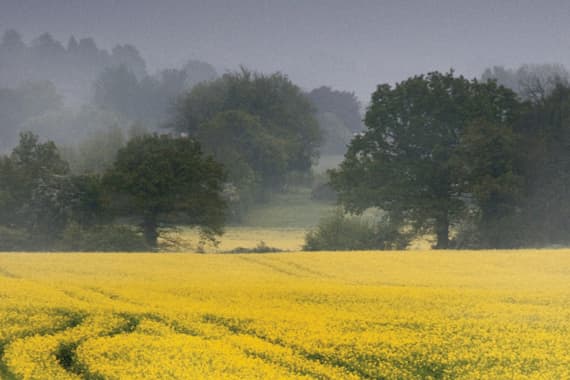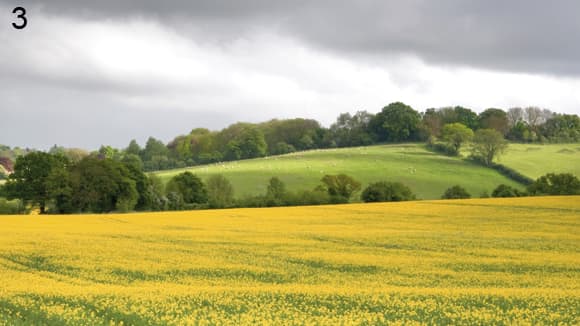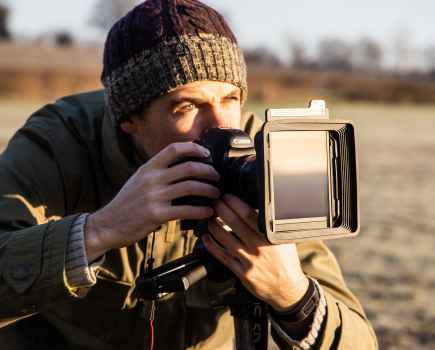When greeted with a stunning vista, it is natural to reach for a wideangle lens to capture as much of the scene as possible. However, what we see in front of us often does not translate well to the photograph that has been captured.
Images can look like a vast expanse of land and sky, with little to draw the viewer or command our full attention. This is because only the centre of our vision is actually in focus, so when we view a large scene our eyes flicker and focus back and forth. As we do this, our eyes piece together all the smaller elements that make up the scene.
For example, standing at the top of a hill looking down into a foggy valley, we may see a road meandering into woodland, the spire of a church breaking through the fog in the distance and a field full of cattle in the foreground. However, if this scene were captured using a wideangle lens, these elements may all appear relatively small and lack impact in the final image, giving a completely different impression to the scene we experienced when standing there.
Most landscape images are taken with a wideangle lens and these have (almost) led us to become conditioned to taking landscape images solely using these optics. But this can often lead to missed opportunities, or images that look like everybody else’s. So, instead of automatically grabbing a wideangle lens, first consider whether there could be an opportunity to photograph the scene from a different angle.
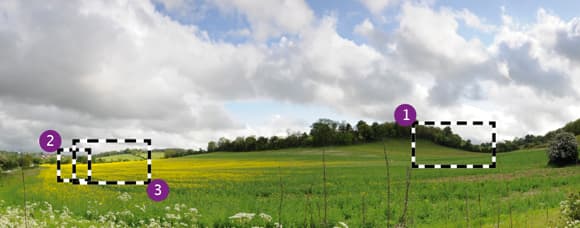
Images: This sweeping panoramic landscape has some nice elements, but they are lost in the image. The three larger pictures below are all taken in exactly the same spot, but using a telephoto lens.
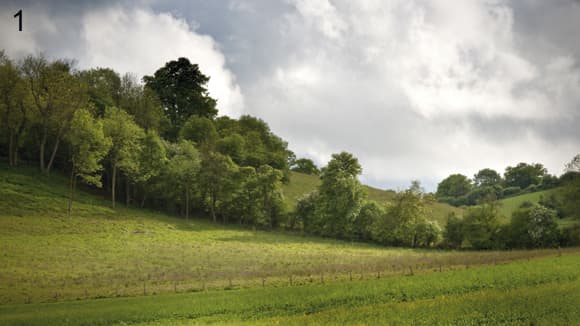
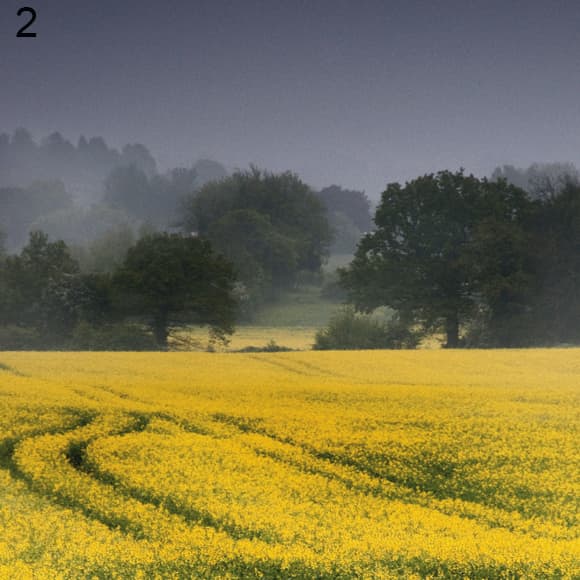
Ask yourself if a particular scene would look better when photographed from further away or perhaps from a higher vantage point. If there is the opportunity to do so, try to use a telephoto lens rather than getting in close to a scene with a wideangle optic. As well as allowing smaller elements of a scene to be captured, the fact that you are standing further away from the subject also offers an entirely different perspective to the view found when using a wideangle lens.
The idea isn’t to completely replace a wideangle lens for landscape images, but to explore alternative views that may require the use of a telephoto optic. Hopefully, the result will be interesting images that would otherwise have gone unnoticed.
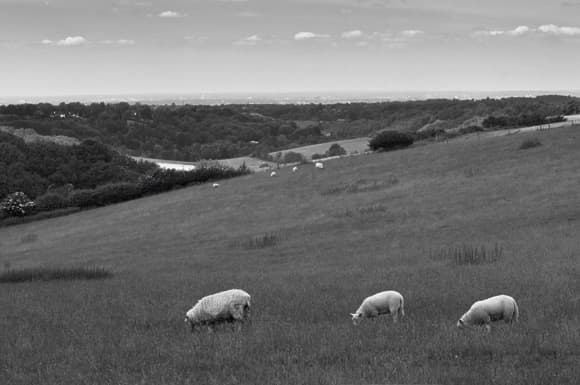
Sometimes a landscape needs some foreground interest, so look out for plants, trees or wildlife that may balance the scene
Focal Length
The area of human vision that is in focus is the equivalent of around a 43mm lens when used on a 35mm camera. Of course, we have peripheral vision, which is much wider, but this area of vision is unfocused. For the purposes of this article we are going to consider any focal length that is wider than around 35mm as wideangle and anything greater than around 70mm as telephoto.
When photographing landscapes a telephoto zoom is ideal, allowing for flexibility as your location and the type of image you wish to take varies. A 70-200mm f/2.8 lens is suitable for most telephoto landscapes, and the f/2.8 aperture allows the depth of field to be shallow when needed. However, such lenses are expensive and a more affordable option would be a 70-300mm f/4-5.6 zoom optic. On a digital SLR with an APS-C-sized sensor, a 70-300mm lens is the equivalent of 105-450mm. At the maximum focal length this allows objects that are far in the distance to be made into the main subject of the image, while the 70mm focal length is wide enough for when you are closer to the main focus of the landscape.
A good compromise may be a ‘superzoom’ lens, such as the Sigma 18-250mm f/3.5-6.3 DC OS HSM or the Tamron 18-270mm f/3.5-6.3 Di II VC. Both of these lenses allow wideangle and telephoto landscape images to be taken, making them ideal for most situations, particularly when you want to travel light. However, the image quality may not match that of a zoom lens with a more limited focal-length range.
Perspective
One of the main reasons for using a telephoto lens for a landscape image is to isolate a particular part of the scene. This can, of course, be done using a wideangle lens and getting in close to the subject, but this produces a very different look to the image as the perspective is altered.
It is not the focal length of a lens that changes the perspective of the image – all the focal length does is alter the angle of view and the magnification of the scene. It is the distance between the camera and subject that alters the perspective, and if you are standing further away, a larger focal length must be used to isolate the subject.
Imagine a scene with a tree just in front of you in the foreground and one in the distance. When you hold your hand up in front of you it appears relative in size to the tree in the foreground. However, perspective means that, despite being smaller, your hand appears to be much larger than the tree in the distance. Our eyes and brain are used to decoding and accounting for perspective as we go about our lives, but it is something we can experiment with when taking photographs.
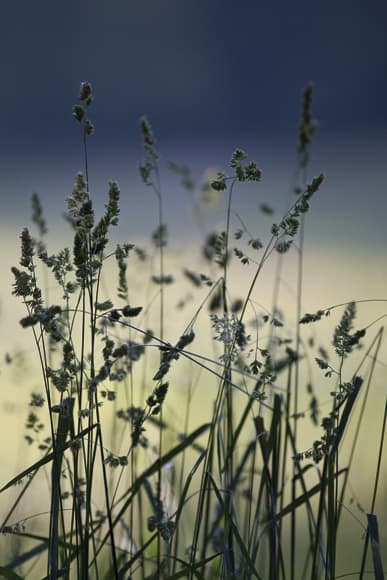
Fog and haze cause image saturation to decrease as the image fades into the distance. This can create interesting shapes and accentuate the foreground subject
Depth of Field
When shooting landscape images, most photographers try to get the maximum possible depth of field and sharpness across the frame. However, although using an extremely small aperture maximises depth of field, diffraction may cause a loss in image sharpness. Most lenses are at their sharpest around 2 aperture stops down from the maximum, which will usually fall somewhere between f/8 and f/11, but depth of field may be limited at these aperture settings.
The simplest solution is to use hyperfocal focusing. This method utilises the fact that an area in front and behind the actual focal point will be in focus. By adjusting the exact point of focus, the depth of field can be moved back and forth to maximise the area that is in focus in the image.
A general rule when taking portrait images is to use a moderately large aperture to restrict the depth of field and concentrate focus on the subject. The same can also be done when taking landscape photographs.
Instead of trying to get as much of the image in focus as possible, use a very large aperture to minimise the depth of field and isolate a subject so that it is the only thing that is in focus in the scene. When using a telephoto lens with a large maximum aperture, it becomes even easier to do this.
The fact that the subject in focus is further away than it would be when photographed with a wideangle lens means that it is easier to get much of the foreground completely blurred and out of focus.
This is particularly true when a lens with a large f/2.8 aperture, such as the Canon 70-200mm f/2.8L IS II, is being used.
Conversely, focusing on the foreground when using a large aperture will render the background a complete blur. The shallow depth of field creates a feeling of depth in the image, while also drawing attention to a particular part of the scene by isolating it from the background.
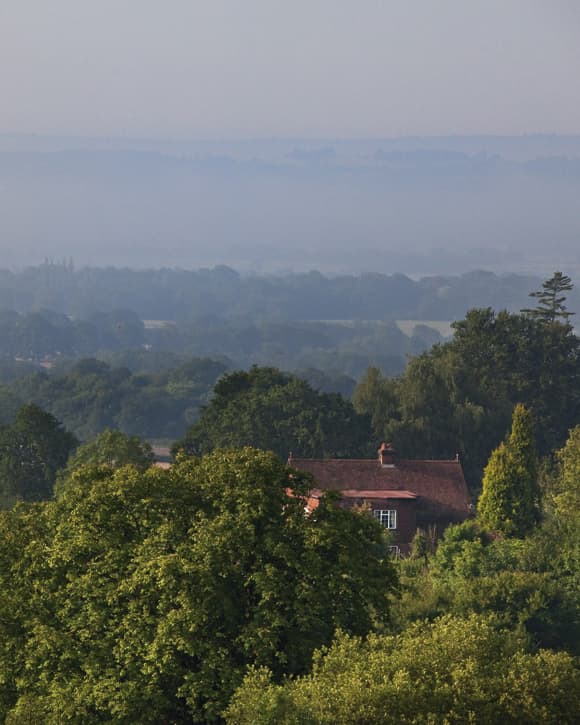
In this image an f/2.8 aperture has made a shallow depth of field, creating a great background for the subject
What to Photograph
As a telephoto lens allows distant subjects to be isolated, it offers the opportunity for a scene to be dissected into various elements. Unlike using a wideangle lens, you are looking to photograph smaller scenes instead of the entire view.
There are a few types of landscape scene that telephoto lenses are particularly well suited to, such as interlocking hills. As contrast is reduced the further away a subject is, ranges of hills become less distinct and less detailed the further away they are. The result is often a layered effect, where each shape of interlocked hill looks like a separate cardboard cut-out, like the background of an early cartoon animation.
Look for interesting shapes and patterns in the landscapes, and try to use the rule of thirds to frame key points. While shapes and patterns can be photographed to make abstract landscape images, often the landscape on its own is not going to be enough to make an interesting image, and a focal point is required. Buildings, trees, farm animals, rivers and lakes are all suitable subjects to make the focus of telephoto landscape images. Once again, use the rule of thirds to place these subjects appropriately in the image. Conversely, lines in crop fields, streams and avenues of trees can all be used as leading lines to draw the eye across a scene towards a subject.
Top tip
1. Stand further away and use a telephoto lens to isolate particular parts of a scene.
2. Look for abstract patterns and shapes in landscapes.
3. Be creative with depth of field to draw attention to the subject.
4. Use a tripod or monopod to support heavy lenses, or use a telephoto lens or camera with good image stabilisation.
UV filters
 Traditionally, UV filters are used to cut out ultraviolet rays of light that are beyond the visible colour spectrum. However, while UV light may not be visible to the naked eye, photographic film and digital camera sensors are sensitive to it.
Traditionally, UV filters are used to cut out ultraviolet rays of light that are beyond the visible colour spectrum. However, while UV light may not be visible to the naked eye, photographic film and digital camera sensors are sensitive to it.
Ultraviolet filters are used in front of a camera lens to absorb UV light and prevent it from reaching the film or sensor. If it does, it can cause a haze and cool blue tint to appear in images, particularly in landscape images of distant scenes taken on bright, sunny days.
However, the need for UV filters has diminished in recent years. First, the coatings that are used on most modern lenses dramatically reduce the amount of UV light entering the camera. Most modern digital SLRs also have filters that cut down on the amount of infrared and UV light hitting the sensor. This reduces the amount of UV light visible in images to virtually nothing, making the need for a UV filter a little redundant, unless you are in a location with a particularly strong level of UV light – at a very high altitude, for example.
There are a few older DSLR models that have particularly weak filters in front of their sensors, making them more susceptible to UV (and infrared) light. Some early DSLRs, particularly the Nikon D70, are known for having weak filters in front of their sensors, and so a UV lens filter may offer additional filtration depending on the particular lens being used on the camera.
Supporting your Camera and Lens
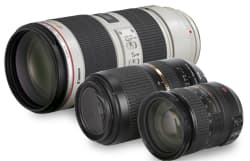 When using a telephoto lens, remember that any slight movement is greatly exaggerated, so it is important to keep the camera and lens steady. Although most cameras and lenses now feature some form of image stabilisation, it is best to use a tripod or monopod for support, particularly if the lighting conditions are not perfect.
When using a telephoto lens, remember that any slight movement is greatly exaggerated, so it is important to keep the camera and lens steady. Although most cameras and lenses now feature some form of image stabilisation, it is best to use a tripod or monopod for support, particularly if the lighting conditions are not perfect.
When mounting a camera on a tripod be sure to switch the image stabilisation off, as it can confuse the stabilisation system into making slight movements during the exposure.
If you are fortunate enough to have a large, heavy telephoto lens with a large aperture, then it needs to be supported. Most large lenses have a collar to mount them on a tripod or monopod, but if not you can still support larger lenses using a beanbag. Simply remove the head from a tripod or monopod, place the beanbag on top and rest the lens on the beanbag.
This should hold the camera and lens steady enough to avoid camera shake becoming a concern.
When using a telephoto lens unsupported, remember the rough rule that the shutter speed should be equal to the 35mm-equivalent focal length being used. So if a 200mm lens is being used on a camera with an APS-C-sized sensor, then the shutter speed should be around 1/300sec. Always err on the side of caution when using this rule, and remember to turn on in-camera or lens-based image stabilisation when shooting handheld.
Perspective
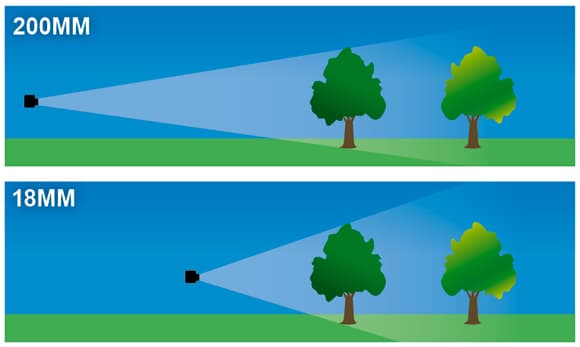
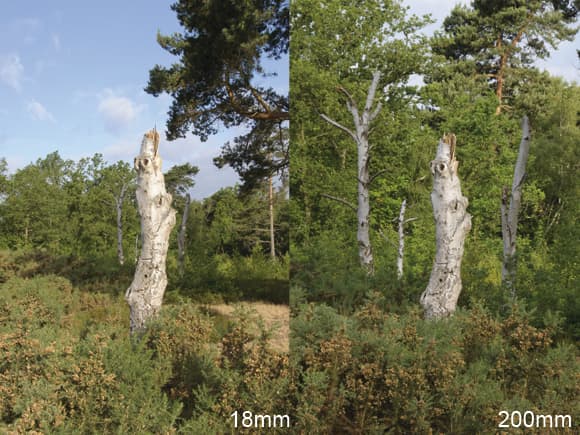
The closer the subject is to a lens, the greater and more exaggerated the effect of perspective. Using a telephoto lens and standing further away reduces this effect.

